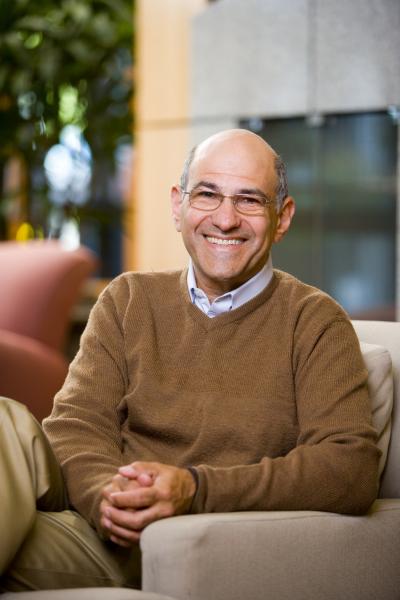Patient Summit USA 2015
Transform care: implement a patient-centric model and build momentum for change across the value chain
Connecting with Cancer Survivors
Andrew Schorr on how pharma can better empower cancer survivors.

According to Andrew Schorr, a medical journalist who was diagnosed in 1996 with chronic lymphocytic leukemia (CLL), we are currently seeing a transition in cancer treatment. It has long been recognized that not all cancers are the same and that treatments vary depending on the mutation that a patient has been identified with, but advances in medical treatments now mean that people can receive targeted treatments for their specific cancer.
Patients receiving targeted treatment tend to do well, with Schorr being a case in point. His CLL diagnosis was almost twenty years ago, but as a result of participating in a clinical trial, he received targeted treatment that turned him from cancer patient to cancer survivor. Schorr’s experiences prompted him to found Patient Power, an online portal that supplies targeted cancer information to both patients and professionals. He has also produced numerous videos and webcasts in order to inspire people in their fight against cancer.
Pharma can help by going the extra mile to inform patients, so they can make sure they are getting the treatment that is right for them.”
Cancer treatments becoming very specific
 Cancer treatment is becoming more complicated as various subsets of cancer are identified; “one size fits all” treatments are now a thing of the past, and pharma play a key role in ensuring patients receive specific care tailored to their individual needs. Take Schorr’s case as an example. “CLL has various subtypes and various drugs to treat these, so a drug that may be used second line for Subtype A may now be used first line for Subtype B,” he explains.
Cancer treatment is becoming more complicated as various subsets of cancer are identified; “one size fits all” treatments are now a thing of the past, and pharma play a key role in ensuring patients receive specific care tailored to their individual needs. Take Schorr’s case as an example. “CLL has various subtypes and various drugs to treat these, so a drug that may be used second line for Subtype A may now be used first line for Subtype B,” he explains.
Schorr does acknowledge that it can be daunting for a cancer specialist to keep up with all the new developments, and that it can be even more difficult for patients. This is where he feels pharma need to up their game. He says, “Pharma can help by going the extra mile to inform patients, so they can make sure they are getting the treatment that is right for them.”
As a patient-advocate, Schorr has garnered support from leading medical centers across America. Heis proof of how connecting with the right doctor and the right medication can be life-saving. Indeed, after being free of cancer for many years, he was again diagnosed with cancer - this time myelofibrosis, for which he received a newly approved medicine in 2012. He is again living well.
Helping patients connect with information
So, how exactly can pharma go that extra mile in helping patients stay informed? Schorr advises that there are different places patients can go to connect with other patients, and recommends the US-based Association of Cancer Online Resources (http://www.ACOR.org), or London-based healthunlocked.com, which lists or links to over 500 communities. Among these communities, a patient is highly likely to find specialized support for their particular illness, which is much more useful than taking advice from people with no experience.
Pharma websites are built by disease, by product and by country. Advertising agencies are contracted to build the site and while they may be very beautiful and cost a lot, they aren’t credible from the patient’s point of view".
“An acquaintance said he had a bone marrow transplant and it worked for him and advised me to try for one,” explains Schorr, “but the clinical trial he was in was stopped as it wasn’t effective for everyone in the trial. While it may have worked for him, in the personalized oncology world it didn’t work for other patients.” He feels that once patients have been given a diagnosis, it is their responsibility to empower themselves with as much knowledge as possible – and pharma can assist with this, either by providing information or signposting.
Schorr likens working to reach the precise answer for a particular patient to climbing Mount Everest. You need to prepare and have the correct equipment, clothing, guides, and training. Patients wanting to beat their cancer diagnosis have to put in the work, as do pharma companies. However, pharma companies, advises Schorr, shouldn’t provide information through their own websites because people don’t go to those sites as a first option. “Pharma websites are built by disease, by product and by country,” he explains.“Advertising agencies are contracted to build the site and while they may be very beautiful and cost a lot, they aren’t credible from the patient’s point of view.” He also feels that pharma websites aren’t updated often enough to keep pace with advances in treatments and medications.
“Pharma is restricted in what they can say by law, their own lawyers, and an approval process that can take a very long time. However, if there is an article in a newspaper about a new development, I am going to go online and look for that information. Pharma, therefore, needs to support independent channels – such as Patient Power, for one, but there are various others,” advises Schorr. He feels strongly that support should come through communication channels that pharma companies don’t control. It could be argued, however, that greater effort needs to go into creating enough trust in pharma for them to be a valued communication channel, as well.
Patient-centricity requires connecting with patients
“Patient-centricity for most has been a hollow term,” states Schorr.“‘We are all about the patient’ is a phrase that doesn’t ring true as many departments within a pharma company don’t know anything about the patient.”
Schorr explains that pharma companies are set up country by country, whereas a patient channel communicates worldwide. For example, if a pharma company was set up in Jamaica, they will have a person in charge in that country whose focus is on the bottom line for their region and not necessarily about what is best for the company overall. One example is Janssen and their medication for prostate cancer, Zytiga®. Schorr points out that since Janssen are currently developing another drug for the same condition, the company would be interested in developing a dialogue with patients regarding the new medication as they have an ongoing commitment to developing the drug. However, should an executive of the company in a certain country be concerned only with maintaining sales of Zytiga®, then patient-centricity is often side-lined.
Unfortunately, pharma companies currently don’t interact with online groups, so they miss out on connecting with these unaffiliated patients".
Overall, Schorr feels that pharma companies should look not only at short-term gains but also the long-term gains to developing partnerships with patient communities. Pharma companies need to really try hard to reach out to connect with patients. Schorr explains, “In my experience, typically, the pharma companies’ dialogue with patients’ stops at advocacy groups. They have contact with only a small percentage of patients, as the vast majority of patients remain unaffiliated. They have a doctor, but aren’t connected with anyone else. The patient or a family member may go online in order to connect with others and they find this connection through online groups. I’m not a member of the Leukemia Society, but I have been a leukemia patient for 19 years. Unfortunately, pharma companies currently don’t interact with online groups, so they miss out on connecting with these unaffiliated patients.”
Pharma companies who are connecting
Some pharma companies are getting it right when it comes to connecting with patients. Take Astra Zeneca, who have six people dedicated specifically to work on patient-centricity, on changing attitudes within the company, dictating how things should be done, and converting to a more patient-centric approach.
Nova Nordisk also incorporates a central focus on the diabetes patient into the company culture. Schorr feels that current silos within companies need to be broken down so the ‘Gods’ of various departments can interconnect. He cites UCB Pharma, whose Chief Patient Affairs Officer, Lode Dewulf, has given presentations and interviews on how patient-centricity is built into the UCB company culture.
Dewulf has highlighted the importance of patient-centricity, stating that patients are‘experts’ on themselves. Instead of a top-down design, UCB has a bottom-up design – putting the patient as number one. The company has determined that putting the patient first will benefit both the company and the patients. For example, a patient may be taking the medication of one company, but once engaged in a productive dialogue, they might decide to switch to the company that has engaged in dialogue – if they produce a better medicine, of course. Furthermore, the company will only be able to produce that medicine if they fully understand the patient’s needs, which can be ascertained through engagement with the patient.
Personalized medicine
With so much focus on personalized medicine designed to meet the individual needs of patients, it is important to highlight the high costs of such breakthrough medicine. Indeed, Schorr shares that the medication he currently takes, Jakafi, costs $85,000 per year. This cost is due to the fact that the medication will only suit a small number of oncology patients. However, Schorr feels the digital age has changed everything and it is no longer about volume but in developing a specific drug for a specific subset of a type of cancer or disease.
Reaching those subsets is made easier in this digital age because, for example, at medical conventions, webcasts of the proceedings are broadcast, allowing patients watching online to ask presenters questions in real-time. As smartphones become computers on the go and websites are increasingly mobile friendly, patients can connect through these phones that, coupled with wearable devices, can send relevant information to their doctor so the patient can expect instantaneous feedback and close monitoring of their condition.
Schorr speaks from experience when he says, “As patients take control of their illness it changes them as people. You live in the moment, are kinder to people and appreciate what you have. People who have been beating cancer for a long time appreciate each new day with all its beauty and take nothing for granted any longer.” This is what patient power is all about – taking control of your disease and accessing the best possible solutions with the help of committed pharma companies and health professionals.
Andrew Schorr will be presenting on the topic "A digital patient's perspective: How only TRUE patient centricity can pay off" at eyeforpharma's Patient Summit USA, October 19-20 in Philadelphia.
Patient Summit USA 2015
Transform care: implement a patient-centric model and build momentum for change across the value chain
